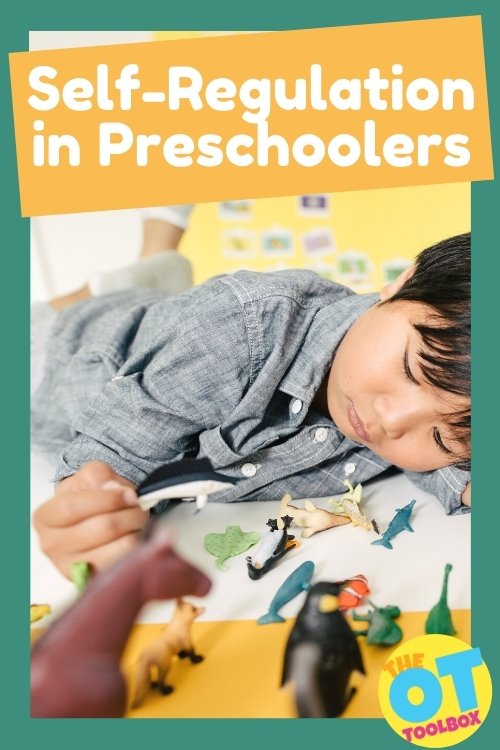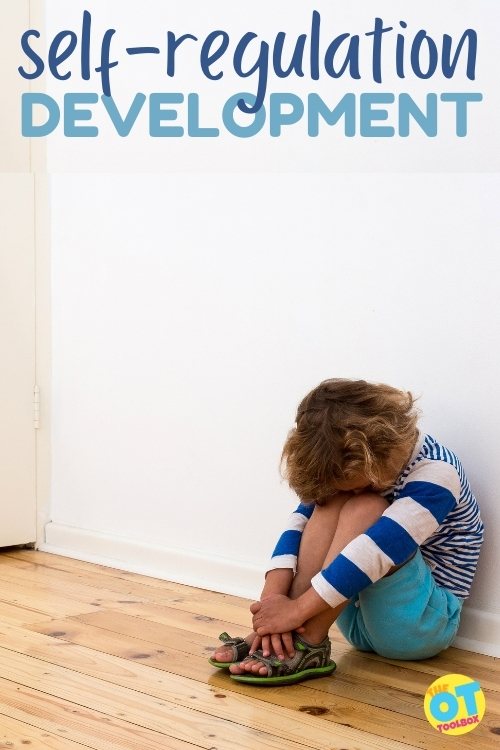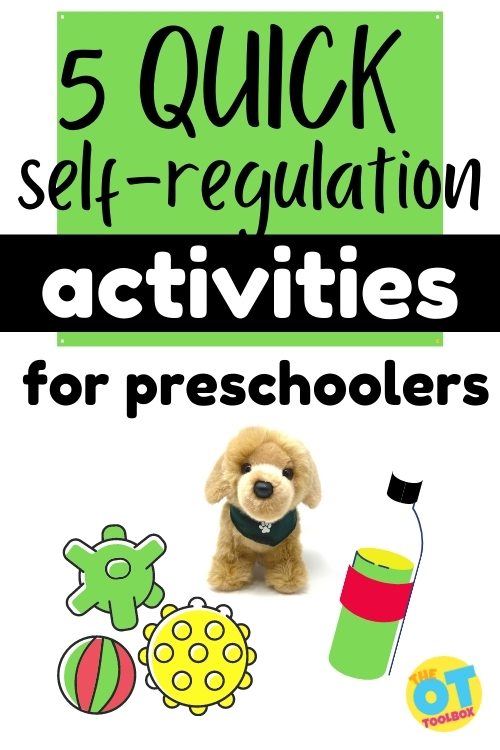Here we are discussing the topic of how to support Self-Regulation in Preschoolers. Self-regulation is a skill that needs to be developed. For our youngest students, identifying emotions, and using self-regulation strategies for preschoolers is just hard. The preschool and Pre-K years are a time to work on emotional regulation through play and experience. Occupational therapy professionals can be a support and a service for parents, teachers, AND preschoolers in OT in the preschool years. Let’s break this down a bit…

This blog includes 5 simple ways to support a preschool child’s ability to regulate their emotions using age appropriate strategies.
Self Regulation in Preschool
Young children feel their emotions before they know what they mean. The first step to responding to a preschooler’s behavior is to understand what they are feeling when they are having trouble with regulation. Sometimes children need others to co-regulate while other times they need time on their own to self-regulate.
When four year old, Anglea, screams at the top of her lungs, we hear the scream, but we don’t feel what she is feeling. The first step to responding to a child’s behavior is to understand how they are feeling.
In order to do this, we need to take a step back and remember what it feels like when we become upset. Do you remember the last time that you were frustrated and wanted to scream?
Like the time that you were running late and you had to stop at every single stop light on the way to the grocery store. You are feeling annoyed right now, but you can deal with it. Then, the only open parking spot was at the every end of the parking lot (and it was next to a HUGE SUV that parked over their side of the line.) Ugh. You feel your fists clenching a bit as you try to squeeze out of your door.
When you walk up to the store, there are no grocery baskets. You walk back to the return basket spot in the parking lot to get a soaking wet basket. You roll your eyes as your patience is tempted. As soon as you walk into the store, you realize the shopping cart you picked is one that “squeals” across the floor. That’s it. You have had enough but you made it into the store and you are going to grab the milk that your two year old wants so she will sleep through the night tonight.
As you rush to the milk aisle, you gasp as the only 2% milk left is the one she won’t drink. Your heart starts to race and you feel like crying. The last thing you want to do is go to another grocery store after the ordeal you already have had. So you grab the off brand milk and say a little prayer that she will drink it tonight.
You’ve had a rough day, but you are almost done. After standing in the 20 minute checkout line (because for some reason the grocery store decided to only have TWO checkout lines open at 5pm on a Friday) you are now able to load your groceries onto the conveyor belt.
You’re next in line. You text your husband that you are hurrying as fast as you can and then the worst thing happens. Over the loud speaker, a voice says “Sorry customers. Due to a technical difficulty, we are only able to accept cash or check. No credit cards are able to be processed.”
How do you feel now? You take three deep breaths as you are trying your best not to scream. You want to fall on the floor and maybe cry? Or you want to toss the milk to the side and run out the door screaming.
You are so upset that you are having a hard time regulating.
But you don’t. You leave the cart, walk to your car (saying some words under your breath) and head to the other grocery store for milk.
Now picture your preschooler feeling that same way. What do they do?

Development of Self-Regulation Skills
Preschoolers need to practice self-regulating skills before they can control their responses. This foundational skill will help them manage their thoughts, emotions and behaviors. Self-regulation skills develop over time. According to this article, even babies are able to self-regulate.
The article states that in infancy, babies are able to self-regulate through strategies:
- Shifting attention or averting gaze when overwhelmed
- Self-soothing by sucking fingers or a pacifier to reduce distress
As children gain new skills, they are able to self- regulate in different ways. This same article discussed the next steps in self-regulation development in the toddler years:
The article describes toddler’s abilities to self-regulate through strategies such as:
- Focusing attention for short periods
- Adjusting behavior to achieve goals
- Beginning to label feelings
- Briefly delaying gratification
- Turning to adults for help with strong feelings
Self-regulation development continues in the preschool years. For kids ages 3-5, self-regulation is experienced in preschool-aged children through strategies such as:
- Recognizing feelings in self and others
- Identifying solutions to simple problems
- With support, using strategies like deep breaths and self-talk to calm down
- Using calm down toys
- Focusing attention and persisting on difficult tasks for increased lengths of time
- Perspective-taking and early empathy
- Coping strategies

Preschool Self-Regulation
Preschoolers love to engage in hands-on activities that teach a variety of concepts. One of the most important concepts is self-regulation. This skill can be taught and practiced at home, at school and out in the community. As children experience the world, there are so many different external circumstances that can trigger a child’s emotions. Each of these experiences gives preschoolers the opportunity to practice self-regulation techniques that they have learned.
Here are 5 ways to teach self regulation strategies to preschoolers:
- Soothing Sammy:
Soothing Sammy is a preschool self-regulation strategy that uses an adorable golden retriever teaches children how to use their sensory system to calm down. The book, plush and playful activities all work together to help children create their own sensory basket they can visit whenever they need some extra calm down tools.
With two simple words, “Sammy Time,” your preschoolers will be redirected to visit Sammy, the plush, at his house, use a cup of water, spot to jump or other sensory materials, to calm down. Once calm, children are able to talk about their feelings and problem solve. Soothing Sammy is perfect for classrooms and homes!
2. Proprioceptive and Movement Based Input:
Taking a heavy work movement break is a great way to redirect ourselves (like when we go for a run or go to the gym to cool down). This works for preschoolers also. Our other article includes over 50 ideas on how to help children calm down, including movement based input such as taking a walk and rocking back and forth in a chair.
When we include proprioceptive input while moving, joint compression increases the ability for us to calm down fast! Some ideas include stomping, squeezing playdough, and stretching!
These emotions playdough mats offer heavy work through the hands while users can identify emotion names associated with facial expressions and feelings.
3. Calming Nature Sensory Bottle:
Looking at calming visuals, like this calming nature sensory bottle, helps redirect our attention to something interesting and beautiful. These easy sensory bottle creation not only supports visual aesthetics, but it also reminds children of being outdoors in nature. This sensory bottle would be a great addition to the Soothing Sammy program.
4. Emotional Vocabulary:
Understanding how to describe our feelings, not only keeps us calm, but also helps us communicate our feelings to others. When children learn the words that match their feelings, they are able to come up with solutions with peers and adults. Playing emotion games, like the ones included in this article, will help even the smallest of children remember emotion words during times of stress.
5. Pretend Play:
Children learn so much while they play. Playing with peers and also participating in pretend play, allows children to act out scenes from different situations. These situations can be happy ones, stressful ones, adventurous ones and so much more! The use of puppets, baby dolls and dramatic play materials helps children formulate situations, discover different responses and make plans for if certain experiences happen in real life. This article goes into more detail about the importance of pretend play in social development.
This article on friendship activities for preschoolers offers more ideas to support social emotional development at this age.
Pretend play is just one of our favorite fine motor activities for preschoolers that supports self-regulation in preschoolers.
As children grow and develop, they experience the world in a variety of different ways. Sometimes everything goes as they planned, and other times, there are unexpected situations where they will need to manage their emotions. By teaching children self-regulation strategies, they will be able to respond to their emotions in a positive way, calmly plan their response and move forward with their day.

Jeana Kinne is a veteran preschool teacher and director. She has over 20 years of experience in the Early Childhood Education field. Her Bachelors Degree is in Child Development and her Masters Degree is in Early Childhood Education. She has spent over 10 years as a coach, working with Parents and Preschool Teachers, and another 10 years working with infants and toddlers with special needs. She is also the author of the “Sammy the Golden Dog” series, teaching children important skills through play.






